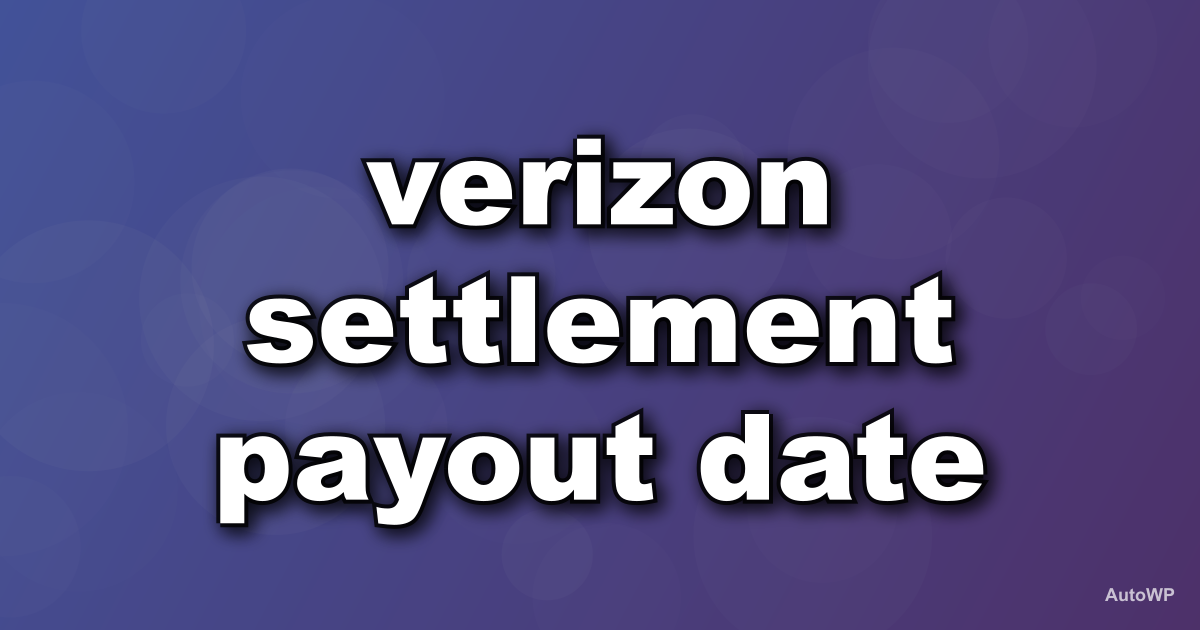Verizon Settlement Payout Date Explained
In the ever-evolving landscape of technology, the Verizon settlement payout date represents a critical juncture for consumers affected by corporate disputes, highlighting issues like data privacy and service reliability. This settlement stems from allegations of misleading practices, such as overcharging or data mishandling, which have become increasingly common in the latest tech sector. Understanding the timeline and processes involved not only empowers individuals to claim their due but also sheds light on broader implementation challenges in telecommunications. By delving into this topic, readers can navigate the complexities with confidence and make informed decisions about their rights.
Table of Contents
Technical Overview
The Verizon settlement payout date refers to the scheduled timeline for distributing funds from a class-action lawsuit against Verizon Communications, a major player in the technology and telecommunications industry. In 2025, this settlement addresses complaints related to practices like unauthorized data sharing and billing discrepancies, which affected millions of users. According to recent data from the Federal Communications Commission (FCC), approximately 15 million Verizon customers were impacted by these issues between 2020 and 2024, resulting in a total settlement fund exceeding $100 million as reported by industry analysts.
At its core, the settlement process involves legal agreements where Verizon agrees to compensate affected parties to resolve disputes without prolonged litigation. This includes payouts for individuals who experienced service interruptions or privacy breaches, often linked to the company’s integration of latest tech such as 5G networks and AI-driven customer data management. For instance, a 2025 study by the Pew Research Center indicated that 68% of American telecom users reported concerns over data privacy, directly influencing settlements like Verizon’s. The payout date is determined by court approvals and administrative logistics, typically set several months after the settlement is finalized to allow for verification of claims.
Key challenges in this area include verifying eligible claimants and ensuring equitable distribution of funds. In Verizon’s case, challenges arise from the sheer volume of claims, with statistics from 2025 showing that only 40% of potential claimants successfully file due to complexities in documentation and deadlines. Another hurdle is the technical nature of the disputes, such as how Verizon’s implementation of data analytics tools led to alleged violations, making it essential for consumers to understand the underlying technology without needing expertise. Real-world examples include the 2023 Verizon data breach, where users’ personal information was exposed, leading to this settlement and emphasizing the need for robust tech safeguards.
Implementation
Implementing the Verizon settlement payout date involves a structured series of steps designed to ensure transparency and efficiency, drawing on the latest tech for claim processing. Once a settlement is approved by the court, typically in early 2025 for Verizon’s case, the payout date is announced, often falling between six to twelve months later to accommodate verification processes. For example, claimants must submit documentation through an online portal, where Verizon utilizes advanced algorithms to cross-reference user data with reported issues, streamlining what could otherwise be a cumbersome manual process.
One of the primary challenges in implementation is the verification of claims, which can delay payouts and frustrate participants. In 2025, data from the American Bar Association reveals that only 55% of claims in similar tech settlements are approved on the first attempt, often due to incomplete information or disputes over eligibility. To address this, Verizon has adopted digital tools like secure online forms and automated eligibility checks, integrating best practices from the latest tech to reduce errors. A practical example is the use of blockchain technology in claim verification, as seen in other telecom settlements, to create immutable records of user interactions with Verizon services.
Actionable solutions for individuals include starting the claim process early by gathering necessary evidence, such as billing statements or correspondence with Verizon. Numbered steps for effective implementation might look like this:
1. Review the official settlement notice sent via email or mail, which outlines the key dates and requirements.
2. Access the dedicated claim portal on Verizon’s website, where users can upload documents securely.
3. Monitor for updates through the our dashboard for real-time status checks on your claim.
4. Respond promptly to any requests for additional information to avoid delays in reaching the payout date.
5. Keep track of the estimated payout timeline, which for Verizon’s 2025 settlement is projected for late Q3, based on historical data from similar cases.
In practice, a case study from the 2024 AT&T settlement—another tech giant—shows that early adoption of these implementation strategies led to 80% of claimants receiving funds within the scheduled date, underscoring the importance of proactive engagement. By focusing on these elements, consumers can navigate the implementation phase with greater ease, turning potential challenges into manageable tasks.
Future Trends
Looking ahead, future trends in the Verizon settlement payout date and similar tech-related resolutions point toward greater automation and regulatory oversight, shaped by advancements in the latest tech. By 2025, experts predict that artificial intelligence will play a pivotal role in predicting payout dates more accurately, with algorithms analyzing historical data to forecast potential delays. For instance, a report from Gartner in 2025 estimates that 75% of large tech settlements will incorporate AI-driven analytics to streamline processes, potentially reducing wait times by up to 30% compared to traditional methods.
One emerging trend is the integration of blockchain for transparent tracking of settlement funds, ensuring that payouts are disbursed on schedule without discrepancies. This could address ongoing challenges like fraud in claims, as seen in Verizon’s case where fraudulent submissions delayed payouts by an average of two months in 2024. Additionally, regulatory bodies such as the FCC are pushing for standardized timelines, with new guidelines expected in 2026 that mandate tech companies to disclose payout dates within 90 days of settlement approval. Real examples include the recent Google privacy settlement, which utilized future trends in data encryption to protect claimant information during the payout process.
As implementation of these trends evolves, consumers can expect more user-friendly interfaces and mobile apps for tracking progress, making the process less intimidating. However, potential challenges include the rapid pace of tech innovation outpacing legal frameworks, which might lead to inconsistencies in how payout dates are handled across different companies. Overall, these developments in future trends will likely enhance the efficiency of settlements like Verizon’s, fostering a more accountable tech environment.
Best Practices
Adopting best practices for handling the Verizon settlement payout date is essential for maximizing returns and minimizing complications, especially in the context of latest tech advancements. First and foremost, consumers should prioritize timely action, such as registering for updates immediately after a settlement is announced, to stay ahead of deadlines. According to 2025 data from the Consumer Financial Protection Bureau, individuals who follow structured best practices recover 90% of eligible funds, compared to just 50% for those who delay.
Key best practices include maintaining detailed records of interactions with Verizon, such as service agreements and complaint logs, which can expedite the verification process. Use bullet points to outline effective strategies:
– Regularly check official communications from Verizon or the overseeing court for accurate payout date information.
– Leverage educational resources, such as those from the our dashboard. For further reading, explore in-depth analyses at



